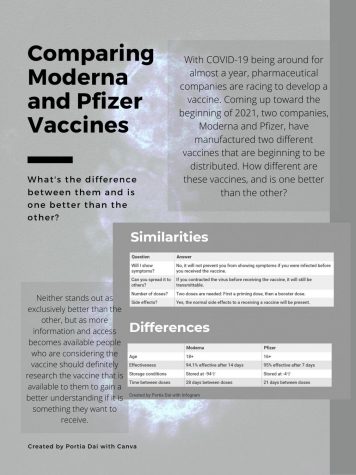College Application Process Timeline
Applying to college is hard, and we’re here to help. Here’s a timeline of the process of applying to college through all four years of high school.
Freshman year
1. Maintain good grades. “The first two years of high school are really the foundation of your HS experience,” says Oakton High School Counselor Mrs. Elizabeth Chase-Kang. Although many people believe that their freshman and sophomore year aren’t as important as the junior and senior years, they are equally weighted in your GPA.
2. Find your passion. Start thinking about what you want to do or what you would like to maybe pursue as a career. You don’t have to be certain, but maybe start getting ideas of things you enjoy doing.
3. Take challenging courses. College admissions representatives want to see that you’re challenging yourself and taking hard core courses. However, do not take hard classes and get bad grades thinking that the difficulty level of the class will make up for the bad grade.
Sophomore year
1. Think about what type of college environment you want. Start thinking about what type of college you want to go to or if you want to go to college at all. Are you into small schools or big schools? Urban or rural or suburban? These are good things to think about.
2. Decide what route is right for you after graduation. Start thinking about whether college is the right route for you after high school. Instead of a 4-year college or university, some students choose to go to 2-year colleges, such as NOVA, and either get their associate’s degree or finish their bachelor’s degree at a 4-year institution. Some students go to tech schools, or two-year colleges that trains and certifies future workers in a specific field of trained labor, such as cyber security institutes and culinary institutes. An example of a tech school is ECPI, which provides degrees and certification in many fields of work. This can be more useful for students because they are typically able to be certified sooner and gain more experience. Students can enlist after high school, or they can join the ROTC (Reserve Officer’s Training Course) program while in college. There is also a AFJROTC (Air Force Junior Reserve Officer’s Training Course) academy class that Oakton students can take as an elective.-There are also Gap Years, which are becoming increasingly popular among students in the US. A gap year is when a student “takes a whole year off of school… and [the student is] doing something planned with your time, whether it be working, a volunteer sight, or going abroad,” says Mrs. Chase-Kang. Students can even defer their admission to a university after being accepted and promise to return after their gap year.
3. Become familiar with college majors that are offered. Some majors sound different than what they really are. You may become interested in majors you’ve never heard of!
Junior year
1. Pick your schedule. Before the school year begins, Mrs. Chase-Kang recommends you pick a “doable, rigorous schedule.” Many students try and take courses that are too hard for them and end up hurting themselves.
2. Research Colleges. Start researching specific colleges that you may be interested in attending. You should hopefully have an idea of what type of college you may want to attend. You can create a customized college search with many different websites, such as College Board or Family Connection, which is available through all students’ Blackboard accounts. While on Family Connection, you can do a search, see all the schools that offer the major you are interested in, and compare yourself to other students who did and did not get into the school you are interested in.
3. Register for the PSAT. You should take the PSAT in early junior year and sign up to get your scores back so you can see how you did and begin preparing for the real SAT. Registration is not required, and you need to pay $17 to get scores back.
4. Begin SAT or ACT preparation classes. Most students begin early in their junior year, but when they begin depends on when the student takes the test and how comfortable they are with testing. It is recommended that students take the tests in the spring of their junior year. Some popular companies to use are Princeton Review, Mindworks, or a private tutor.
5. Start taking college tours. Start taking college tours to get an idea of what you look for in a college. “They may not be the exact schools you end up applying to, but you can eliminate schools,” says Mr. Charles Grausz, another counselor at Oakton. It is important to know what a college is like in real life, and many say that one of the biggest deciding factors about whether or not to go to a college is the way you feel when you walk on campus. It is important to feel like this is the school for you since it will be your home for the next four years of your life. Try and go while school is in session so you can see what it is like with students on campus.
6. Local College Visits. If you can’t visit a school, many college representatives visit Oakton and give information sessions for prospective students. The visit dates and sign ups are located on Family Connection. Tours and meetings are also recommended so you stick out to the school representatives. It helps to ask them important, specific questions about the school so you seem knowledgeable and interested in the school.
7. Start narrowing down schools. It’s okay to begin with more schools than you can count if you don’t know exactly what you want yet. Once you start figuring it out, you can narrow down colleges based on majors and overall feel of the school. Don’t know what you want to do in college yet? That’s okay! An estimated 20-50% of students apply to college undecided. It is just important to make sure you love the environments of the colleges you choose. Try to choose one with a broad enough selection of programs and majors for you to try out what you want to
8. Take the SAT or ACT. Set a personal goal that you want to achieve to get into the colleges you are looking at. Some colleges also require SAT Subject Tests, or tests that show your knowledge or interest in a specific topic not demonstrated on the SAT, so check with the schools you are applying to and see if any do require them. It is also recommended that students take the SAT or ACT multiple times because most schools super-score. This means that they take your highest scores from each section and combine them, which usually raises the score.
9. Teacher Recommendations. Most college applications require teacher recommendations. It is important to choose a teacher that you have a good relationship with or whose class you actively participated in and demonstrated good character in. Teachers are asked to do many recommendations and do not say yes to all of them, so make sure you ask them early on.
Senior year
1. Knowing the difference between Early Decision, Early Action, and Regular Decision. It is important to know when you want to apply to your colleges you’ve chosen. Early decision is a binding agreement with the college stating that if you are accepted, you will attend that school. If a student chooses to apply early decision, they should be positive that the school they have chosen is their number one choice and they absolutely want to attend and are able to pay for it. Not many students apply early decision, so if you are very serious about a school, it may be a good choice because their is a smaller pool of applicants. Early action is usually used when a student is also serious about the school but want options. Early action is becoming more and more popular because to many colleges, it shows you are interested in that school, and depending on the school, you may have a greater chance for financial aid. However, it is important that a student doesn’t rush through their application or submit anything but their best work in order to meet the deadline. “Never push send until it’s the best you can be… if you’re ready to go, and you’re ready to send your best, by all means go early,” says Mr. Grausz. Although it depends on the school, early action and decision deadlines are usually pretty early, typically around November or December. Regular decision is the most popular deadline used by applicants. This deadline is usually later in the year, typically around January or February. You can apply to any of your colleges with this deadline, whether they are your top schools or your safeties. Many people apply regular to make sure they have a good application or if they need to get their test scores or grades up before they apply and they need some time in senior year to do so.
2. Apply. Many schools in the US use the Common Application, but many schools also have their own application. Students are encouraged to apply to around five to eight colleges. This group should contain reach schools, or schools you are stretching to get into, solid matches that are just right for you, and safety schools that you could definitely get into. However, you should be happy to attend all these schools. Pay close attention to what each school requires when it comes to GPA and SAT/ACT scores, and also to what it takes to complete the application. Usually, essays and recommendations are required for most colleges. In order to get a counselor recommendation, students must fill out the senior profile by the due date to get a recommendation. They also must make sure they have teacher recommendations if they did not get any during junior year. It is also important that students fill out their transcript request forms so a transcript can be sent to the colleges they’re applying to, which is required for most applications. If you need assistance, you can contact your counselor and ask questions.
3. Look for financial aid. One of the most popular forms of aid is the FAFSA. Also known as the Free Application for Federal Student Aid, you are required to fill out the FAFSA in order to get need-based money from the government which you don’t have to pay back. A common misconception is that some people think they won’t apply for financial aid because it is based off of income. However, even if you don’t get any money, it is still important to fill it out because some colleges give out their own grants based off of the FAFSA. You can also do a work-study with your college where you work for the college and the money you earn goes towards your tuition. The schools also offer need-based and merit-based scholarships directly from the school, which depends on your current financial situation and your grades and scores. There are also private scholarships that can come from different organizations, companies, or even people. There are scholarships for many different people that are given for a variety of reasons. Family Connection on Blackboard has many different types of scholarships listed for students to apply for. Some even come directly from Oakton High School!
4. Avoid Senioritis. While waiting for the decision to arrive, make sure you maintain good grades. Colleges can rescind their acceptances if students drop their grades too much. It is also important to try and avoid “senioritis” and not skip school. It looks very bad to colleges when a student has a poor attendance record, and students can get in trouble with the school if they miss too many school days.
5. Choosing a college. If you have gotten into schools, unfortunately you must choose one. Important factors to consider after being admitted is cost and how you feel about the school. Ask yourself if you feel like you belong there and could see yourself there for the next four years. Also make sure you can pay for the school, especially based off of how much financial aid you receive.






